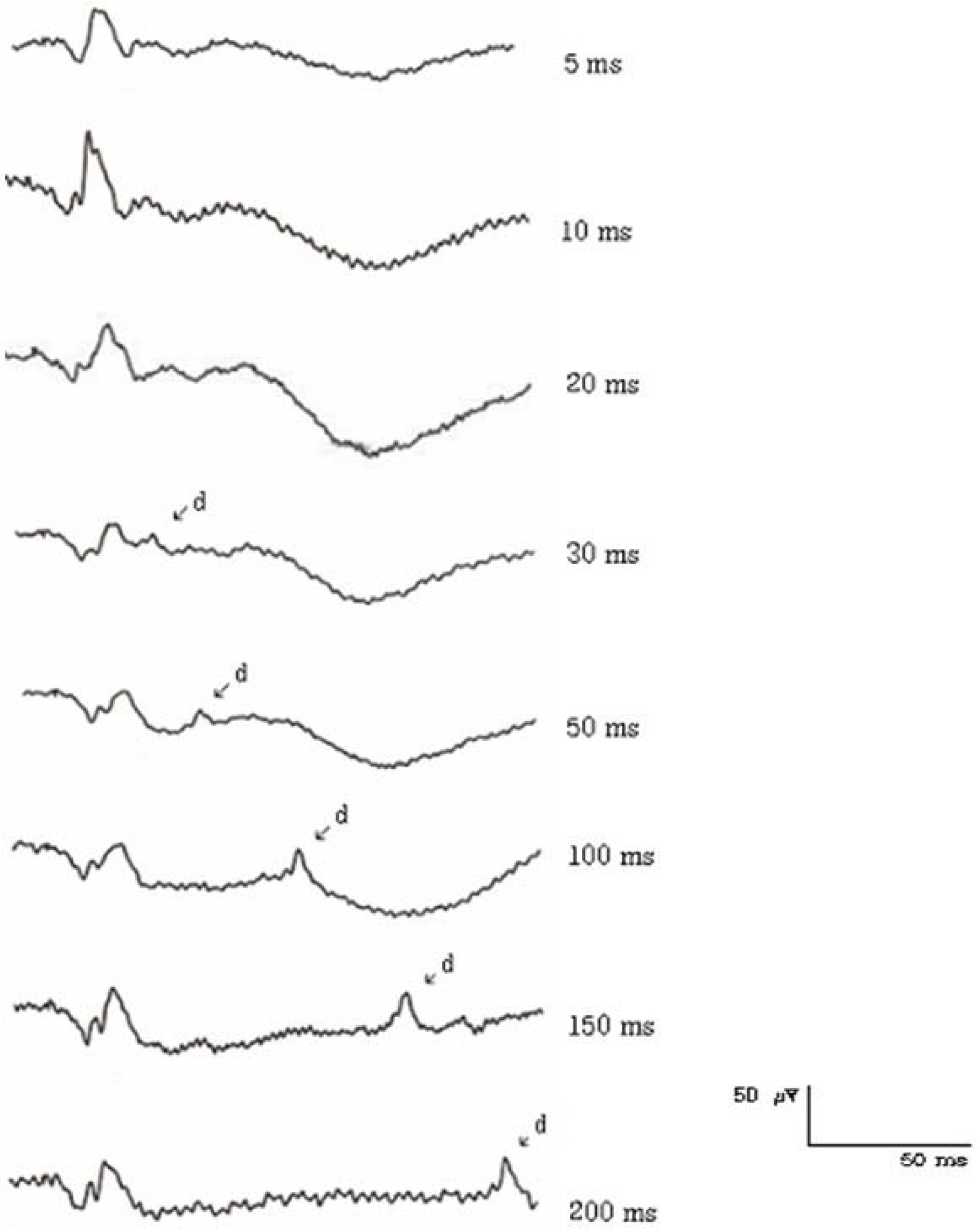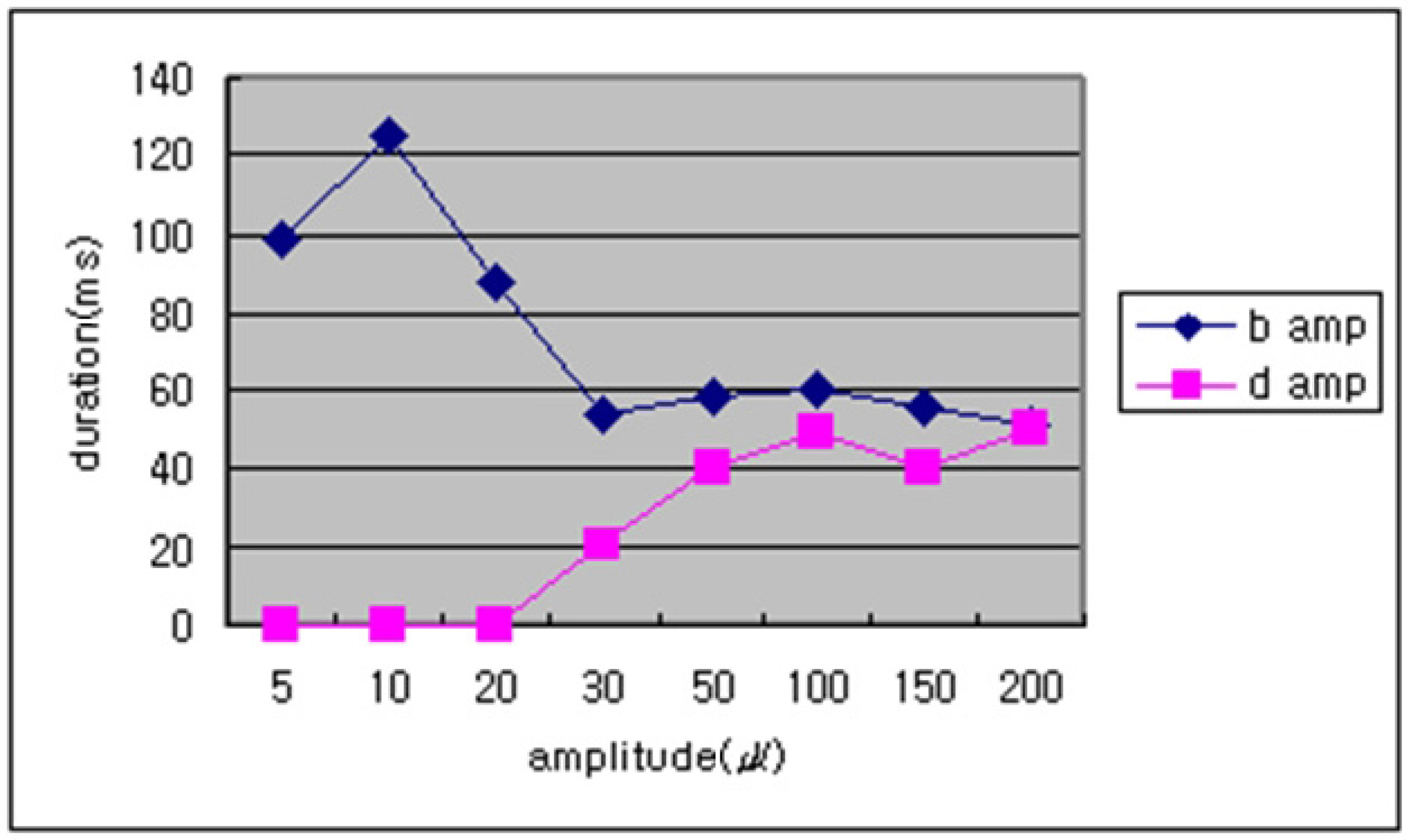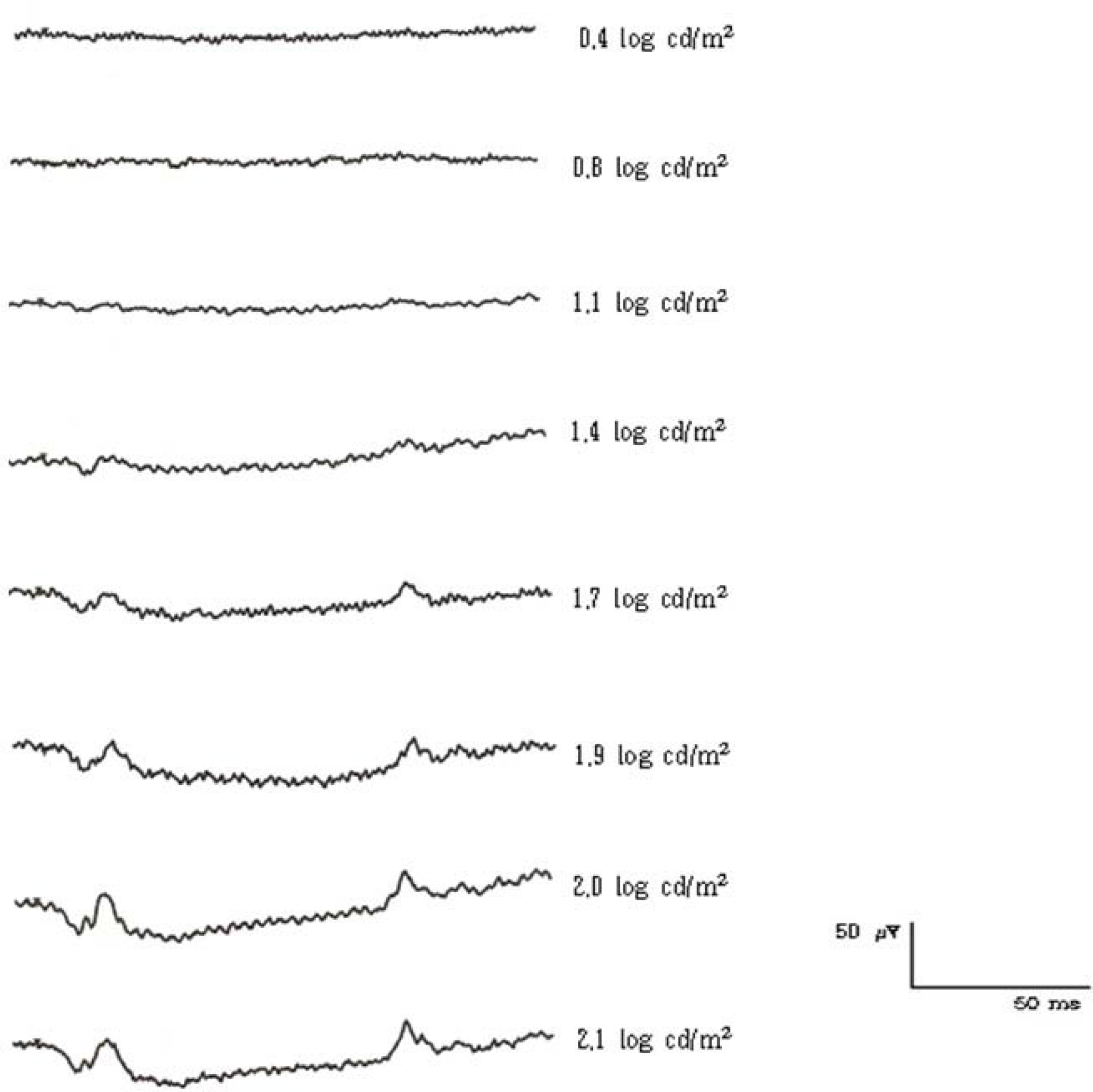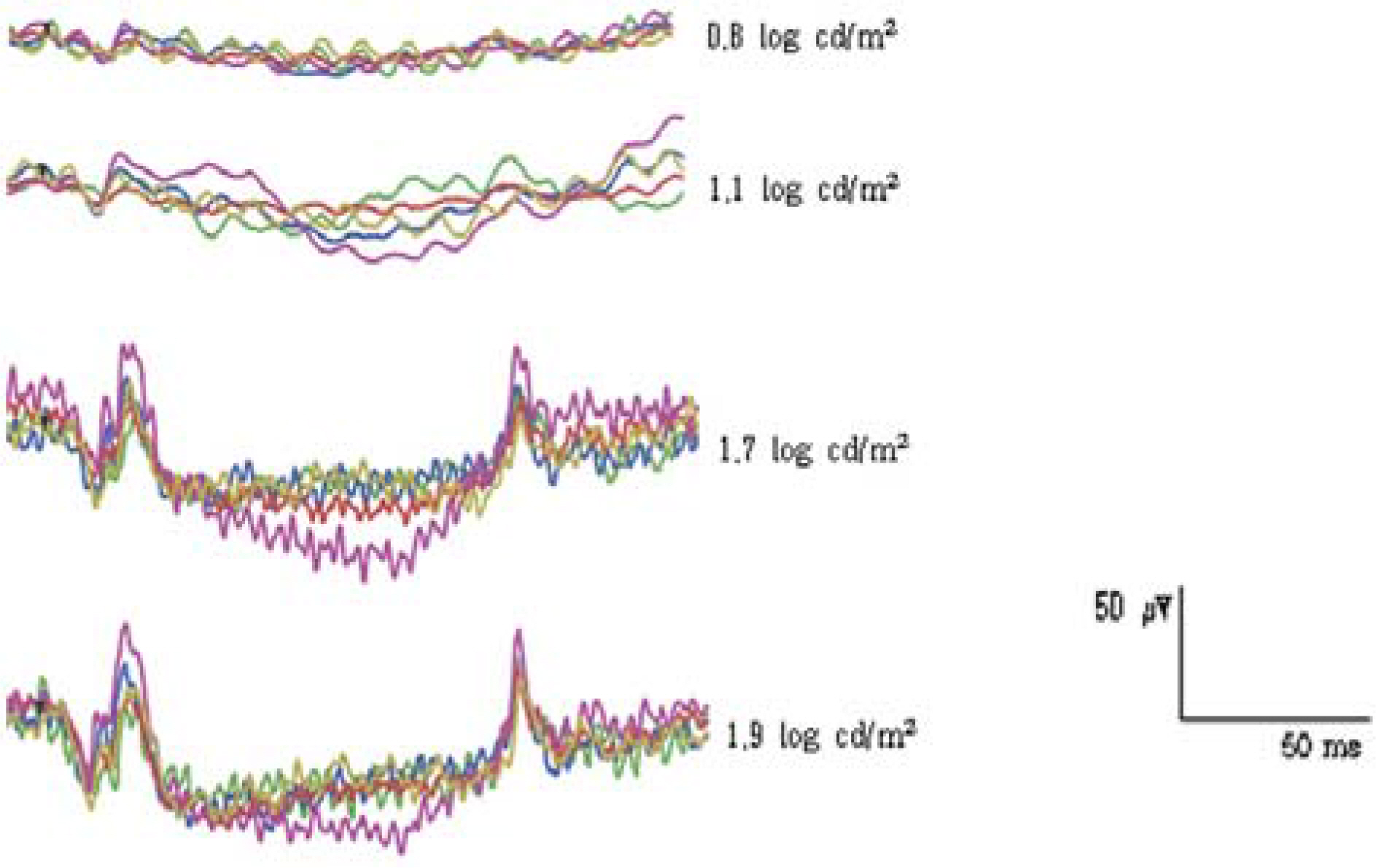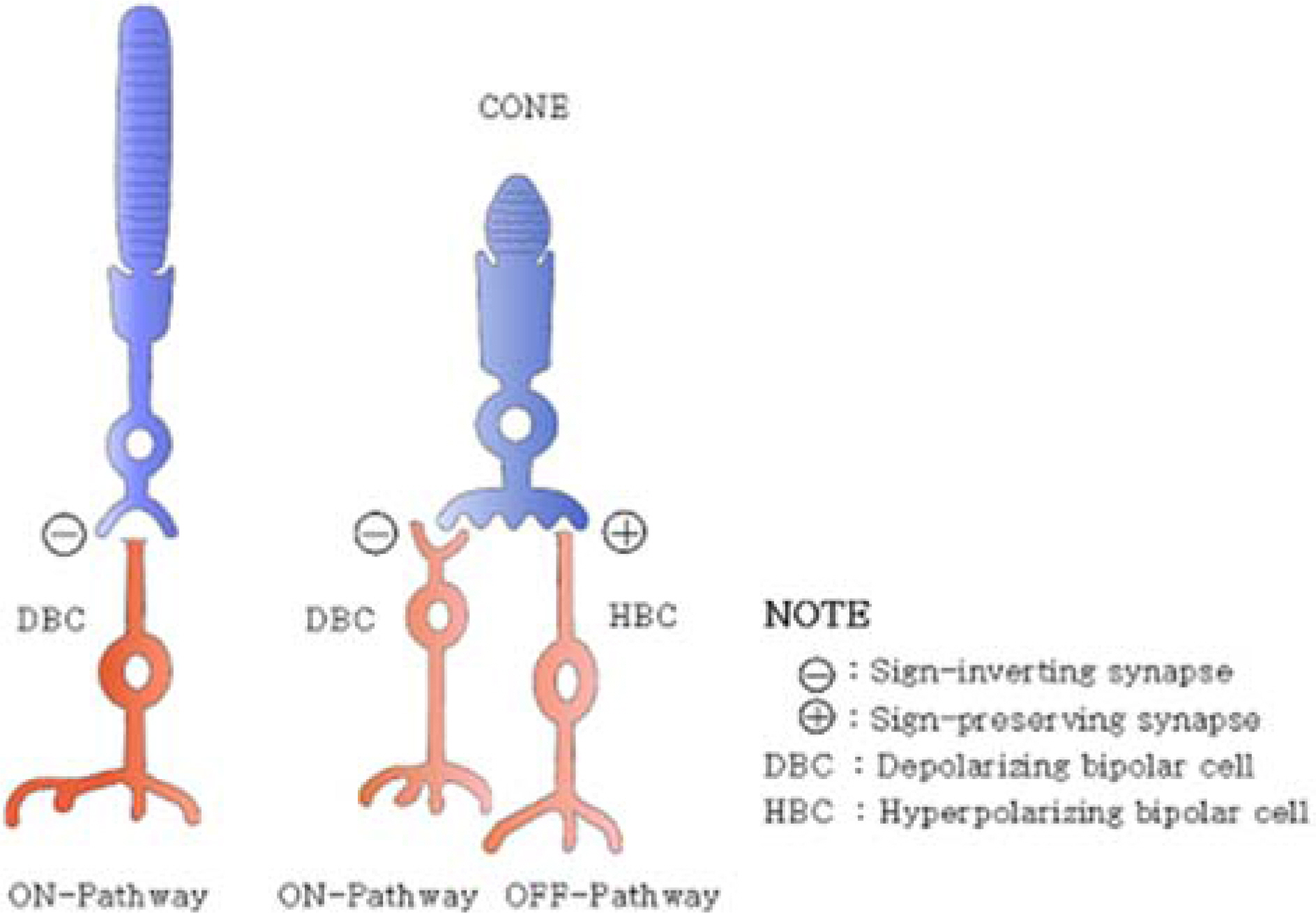J Korean Ophthalmol Soc.
2008 Mar;49(3):471-478. 10.3341/jkos.2008.49.3.471.
Photopic ON- and OFF- Responses in Korean Normal Subjects
- Affiliations
-
- 1Department of Ophthalmology, College of Medicine, Soonchunhyang University, Bucheon, Korea. yhohn@sch.ac.kr
- 2Department of Ophthalmology, College of Medicine, Ewha Womans University, Seoul, Korea.
- KMID: 2211321
- DOI: http://doi.org/10.3341/jkos.2008.49.3.471
Abstract
- PURPOSE
To explore the effects of stimulus duration, stimulus intensity, and background luminance on the amplitude and waveform of the ON- and OFF- responses of photopic ERG and to provide standard parameters of ON- and OFF- responses for normal Korean populations.
METHODS
Twenty normal subjects (20 eyes) were enrolled to record photopic ON-and OFF-responses using a contact lens electrode with built-in LEDs and an LED-driver. The influence of stimulus duration on wave amplitudes was studied at flash durations that varied from 5 to 200 ms. The influence of stimulus intensity was studied with 0.4, 0.7, 1.1, 1.4, 1.7, 1.9, 2.0, and 2.1 log cd/m2. In addition, the influence of background luminance was studied with 20, 30, 40, and 50 cd/m2.
RESULTS
Among 20 normal subjects, the d-waves in 16 subjects were isolated from b-waves with more than 50 ms of stimulus duration. The d-wave was observed for a 30-ms stimulus duration in 3 subjects and for a 100-ms duration in 1 subject. The amplitudes of the b-and d-waves increased as stimulus intensity was increased. The amplitudes of b-and d-waves decreased as background luminance was increased.
CONCLUSIONS
Our results suggest that the clinical use of ON-and OFF-response recording can be obtained with stimulus parameters from 100 to 150 ms in duration and a 1.7-2.1 log cd/m2 intensity under 30-40 cd/m2 background luminance.
MeSH Terms
Figure
Reference
-
References
1. Marmor MF, Zrenner E. Standard for clinical electroretinography. Doc Ophthalmol. 1995; 89:199–210.
Article2. Sieving PA. Photopic ON-and OFF-pathway abnormalities in retinal dystrophies. Trans Am Ophthalmol Soc. 1993; 91:701–73.3. Alexander KR, Fishman GA, Peachey NS, et al. ‘ON' response defect in paraneoplastic night blindness with cutaneous malignant melanoma. Invest Ophthalmol Vis Sci. 1992; 33:477–83.4. Quigley M, Roy MS, Barsoum-Homsy M, et al. On- and off-response in the photopic electroretinogram in complete type congenital stationary night blindness. Doc Ophthalmol. 1996–7; 92:159–65.5. Kabanarou SA, Holder GE, Fitzke FW, et al. Congenital stationary blindness and a “Schubert-Bornschein” type electro-physiology in a family with dominant inheritance. Br J Ophthalmol. 2004; 88:1018–22.6. Downes SM, Holder GE, Fitzke FW, et al. Autosomal dominant cone and cone-rod dystrophy with mutations in the guanylate cyclase activator 1A gene encoding guanylate cyclase activating protein 1. Arch Ophthalmol. 2001; 119:96–105.7. Allen LE, Zito I, Bradshaw K, et al. Genotype-phenotype correlation in British families with X-linked congenital stationary night blindness. Br J Ophthalmol. 2003; 87:1413–20.8. Miyake Y, Yagasaki K, Horiguchi M, et al. On-and off response in photopic electroretinogram in complete and incomplete types of congenital stationary night blindness. Jpn J Ophthalmol. 1987; 31:81–7.9. Fitzgerald KM, Cibis GW, Giambrone SA, et al. Retinal signal transmission in Duchenne muscular dystrophy: evidence for dysfunction in the photoreceptor/ depolarizing bipolar cell pathway. J Clin Invest. 1994; 93:2425–30.10. Chen C, Zuo C, Piao C, Miyake Y. Recording rod ON and OFF responses in ERG and multifocal ERG. Doc Opthalmol. 2005; 111:73–81.
Article11. Usui T, Tanimoto N, Ukei S, et al. Night blindness with depolarizing pattern of ON/OFF response in electroretinogram: a case report. Doc Ophthalmol. 2005; 111:15–21.
Article12. Schiller PH. The On and Off channels of the visual system. Trends Neurosci. 1992; 15:86–92.
Article13. Falk G. Retinal physiology. Hekenlively JR, Arden GB, editors. Principles and Practice of Clinical Electrophysiology of Vision. St Louis: Mosby;1991. chap. 7.14. Stell WK, Ishida AT, Lightfoot DO. Structural basis for on-and off-center responses in retinal bipolar cells. Science. 1977; 198:1269–71.15. Sustar M, Hawlina M, Brecelj J. ON- and OFF-response of the photopic electroretinogram in relation to stimulus characteristics. Doc Ophthalmol. 2006; 113:43–52.
Article16. Kondo M, Piao CH, Tanikawa A, et al. Amplitude decrease of photopic ERG b-wave at higher stimulus intensities in humans. Jpn J Ophthalmol. 2000; 44:20–8.
Article17. Seiple W, Holopiqian K. The ‘OFF' response of the human electroretinogram does not contribute to the brief flash ‘b-wave'. Vis Neurosci. 1994; 11:667–73.18. Hogg C. The use of light emitting diodes in electrophysiology and psychophysics. Heckenlively JR, Arden GB, editors. Principles and Practice of Clinical Electrophysiology of Vision. St Louis: Mosby;1991. chap. 28.19. Kondo M, Piao CH, Tanikawa A, et al. A contact lens electrode with built-in high intensity white light-emmitting diodes. Doc Ophthalmol. 2001; 102:1–9.
- Full Text Links
- Actions
-
Cited
- CITED
-
- Close
- Share
- Similar articles
-
- ON and OFF Responses of the Electroretinogram in Patients with Glaucoma
- Photopic Flash ERG Changes in Diabetic Retinopathy: with reference to severity of diabetic retinopathy
- Visual Field in Normal Korean Subjects: Traquair's "Hill of Vision"
- Photopic Negative Response (PhNR) in Normal Subjects
- Simultaneous Recording of Flash Electroretinography and Visual Evoked Potential in Vitreous Hemorrhage with Diabetic Retinopathy


